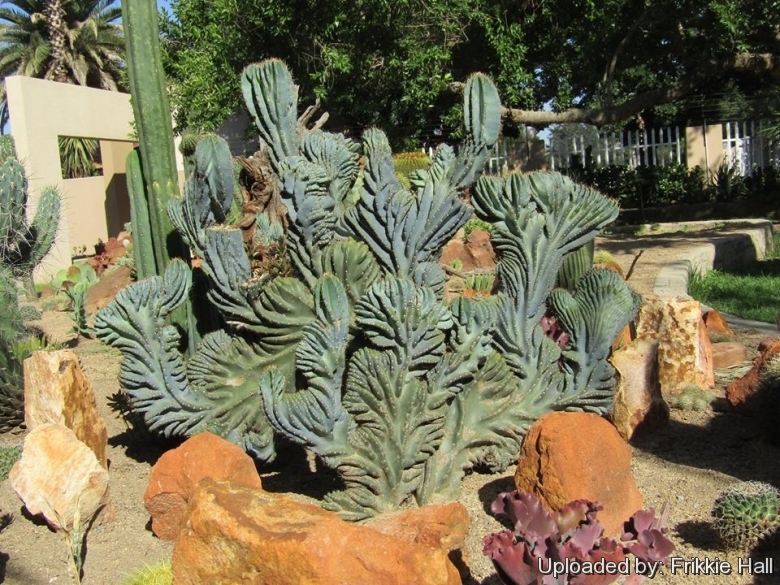
Cereus peruvianus f. cristatus Photo by: Frikkie Hall
Origin and Habitat: Garden origin (Nursery produced cultivar).
Synonyms:
See all synonyms of Cereus peruvianus
Description: Cereus peruvianus f. cristatus is an unusual form of what is normally a columnar cactus. The standard Cereus peruvianus) is a perennial treelike stem succulent with many upright or slightly curved branches above, often with distinct trunks up to 10 m high.
Stems: Fan shaped, whorled, grey-green to blue-green, 6-8(-10) cm thick growing to 1 metre tall by the same width.
Ribs: Fairly low, rounded, somewhat compressed and undated, about 0,5 cm high.
Areoles: Small, widely separated with greyish-white wool.
Spines: Often numerous, sometimes absent, grey, needle-like, bristly reddish-brown.
Flowers: Nocturnal, each flower opens for just one night and then shrivels up, white with reddish tips, 12-15 cm long.
Blooming season: During the warm season Cereus peruvianus produces several flower flushes, but crested specimens often fail to flower (depending on clones).
Fruits: Globose to elongate up to 4 cm long, thornless usually red with white pulp, but skin colour vary from yellow to deep violet-red.
Subspecies, varieties, forms and cultivars of plants belonging to the Cereus repandus group
Bibliography: Major references and further lectures:
1) Edward Anderson “The Cactus family” Timber Press, Incorporated, 2001
2) James Cullen, Sabina G. Knees, H. Suzanne Cubey "The European Garden Flora Flowering Plants: A Manual for the Identification of Plants Cultivated in Europe, Both Out-of-Doors and Under Glass" Cambridge University Press, 11/Aug/2011
3) David R Hunt; Nigel P Taylor; Graham Charles; International Cactaceae Systematics Group. "The New Cactus Lexicon" dh books, 2006
4) Thomas Mawe, John Abercrombie “The Universal Gardener and Botanist: or, a general Dictionary of Gardening and Botany” 1778
5) Urs Eggli, Leonard E. Newton: “Etymological Dictionary of Succulent Plant Names” Springer, Berlin/Heidelberg 2010
6) N. L. Britton, J. N. Rose: “The Cactaceae. Descriptions and Illustrations of Plants of the Cactus Family.” Volume II, The Carnegie Institution of Washington, Washington 1920
7) Park S. Nobel “Cacti: Biology and Uses” University of California Press, 2002
8) Jules Janick, Robert E. Paull “The Encyclopedia of Fruits and Nuts” CABI, 2008
9) Peter Hanelt, Richard Büttner “Mansfeld's Encyclopedia of Agricultural and Horticultural Crops: (Except Ornamentals)” Springer, 01/Jan/2001
10) J. Weiss, A. Nerd, and Y. Mizrahi. “Development of Cereus peruvianus (Apple Cactus) as a new crop for the Negev desert of Israel” p. 486-471. In: J. Janick and J.E. Simon (eds.), New crops. Wiley, New York.1993.
11) David Yetman “The Great Cacti: Ethnobotany & Biogeography” University of Arizona Press, 2007
12) “The Journal of the Royal Institution of Great Britain”, Volume 1 - Royal Institution of Great Britain 1831
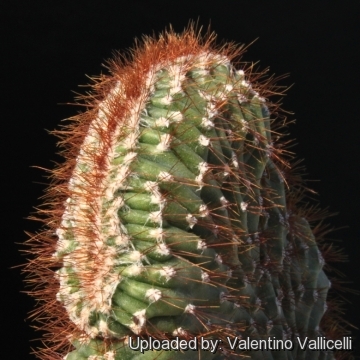 Cereus peruvianus f. cristatus Photo by: Valentino Vallicelli
Cereus peruvianus f. cristatus Photo by: Valentino Vallicelli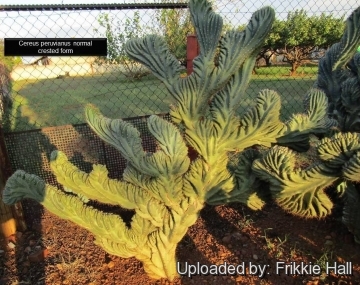 Cereus peruvianus f. cristatus Photo by: Frikkie Hall
Cereus peruvianus f. cristatus Photo by: Frikkie Hall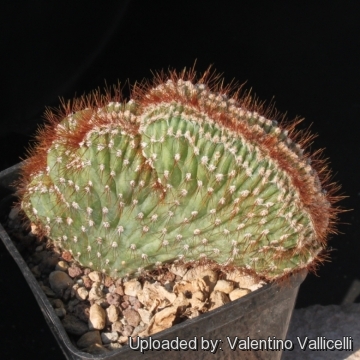 Cereus peruvianus f. cristatus Photo by: Valentino Vallicelli
Cereus peruvianus f. cristatus Photo by: Valentino Vallicelli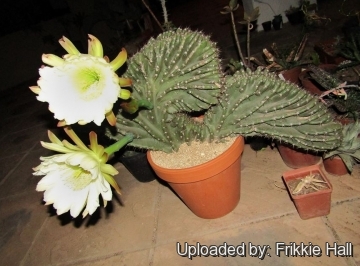 Cereus peruvianus f. cristatus Photo by: Frikkie Hall
Cereus peruvianus f. cristatus Photo by: Frikkie Hall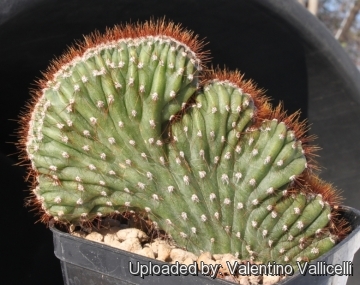 Cereus peruvianus f. cristatus Photo by: Valentino Vallicelli
Cereus peruvianus f. cristatus Photo by: Valentino Vallicelli Cereus peruvianus f. cristatus Photo by: Frikkie Hall
Cereus peruvianus f. cristatus Photo by: Frikkie HallCultivation and Propagation: Plant in a porous cactus soil with adequate drainage for best results. Bright light with ample airflow. Water thoroughly during the growing season when soil is dry to the touch. Less or no water during cold winter months to prevent root loss. It is cold intolerant. Make sure they it is not exposed to freezing temperatures ( Hardy to -2°C) or it may die. Since it is a relatively rapid grower, it needs plenty of space for its roots. Repotting should be done every other year, or when the plant has outgrown its pot.
Propagation: It is easily propagated from cuttings in spring, giving the wound time to heal. Then replant them in fresh cactus soil that is ever so slightly moist, and keep them that way till they root. This cutting should root within a month or two. They can also be grown from grafting.
















